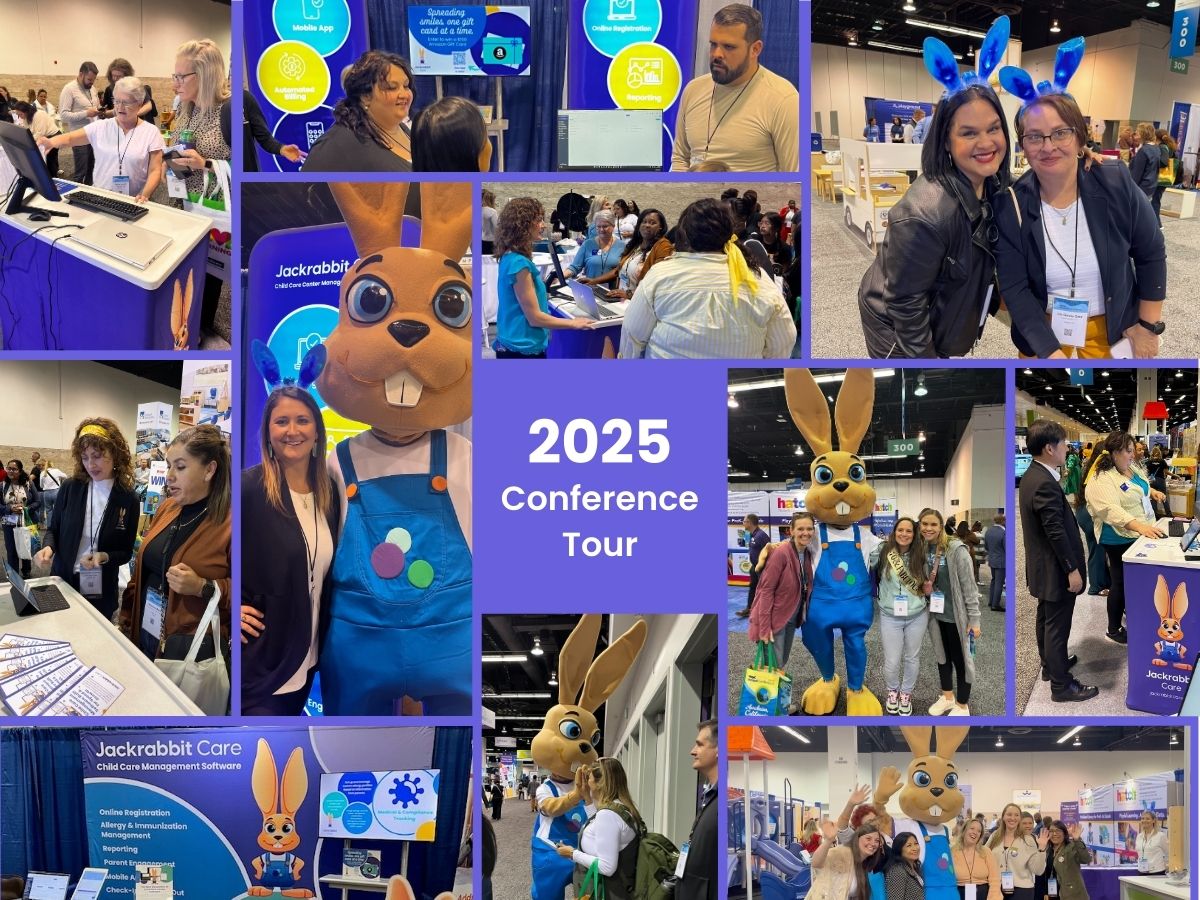The happiness factor among your employees is critical to the success of your facility.
We at Jackrabbit believe this. In fact, it is one of the core beliefs of our owners. Jackrabbit president, Mark Mahoney, will tell you that he is focused his employees’ happiness factor because he knows that it takes happy employees make happy customers.
When employees are happy, they are loyal, passionate, conscientious and energetic, they are also “contagious.” In other words, their positivity spreads to co-workers, customers, partners, family members – everyone who interacts with them. You’ll find that people are happy to interact with your happy employees.
I raise this point because January is a great time to put new initiatives and policies in place and your relationship with your employees is a great place to start. Call it turning over a new leaf in your relationship with employees if you’d like, but review the happiness level of your employees and consider changes you can make to raise this level. You’ll see amazing improvements in other areas of your business.
If you don’t have a good bead on the happiness factor around you, do an anonymous employee survey (annually). Encourage your employees to be honest. They will do this when they know that their comments won’t haunt them later.
I recently read a list of practices that – when implemented – can inspire people to love working where they work. There is a common theme in each of the twelve points: a focus on people. None of these points focuses on money, benefits or workload, but on emotional factors that influence how employees feel about themselves and the job they do.
I’ve shared Roger Neugebauer’s twelve item list noted in “12 Reasons People Love to Work for You” from the Child Care Exchange and included some of his comments.
You believe in people from day one.
With the shrinking supply of qualified teachers, there is a tendency to be pessimistic about the potential of the people we hire. This pessimism can result in a self-fulfilling prophecy: we don’t expect high performance, so we don’t make an effort to encourage high performance; and, in the end, we don’t see high performance.
You can’t manipulate people like puppets. They alone have the power to decide whether they will work hard.
However, your attitude about a person can have a significant dampening or buoying impact on their self-confidence. When you believe a person has the potential to succeed, and when you believe that a person has a desire to succeed, your support can make a difference.
You build on people’s strengths.
You will never find the perfect teacher, cook, bookkeeper, or bus driver (or spouse, for that matter). All of us have our shortcomings. However, we don’t hire people because of their weaknesses. We hire them because we see some talent, some experience, or some trait that is a strength that we need.
To help new employees succeed on the job, you need to focus on the reasons you hired them. Time devoted to building on people’s strengths is time well invested. Time spent in trying to fix people’s weaknesses is, more often than not, time wasted.
There always will be occasions when you must affirmatively deal with poor performance, which is directly affecting the quality of your program: conflict, absenteeism, inappropriate discipline, and so on. However, focusing all your energy on people’s shortcomings results mostly in frustration, anger, and alienation (anyone with teenagers can relate to this).
You provide people with feedback.
One of the most frequent complaints I hear from teachers is that they do not receive feedback on their efforts. They do not know if the director thinks they are doing a good job overall, or if the director even cares about what they are doing.
According to management guru Peter Drucker, what employees most need to improve their performance is an abundance of objective, timely feedback on the results of their performance. In well-functioning centers, the director places a high priority on encouraging staff to provide feedback to each other, in training staff on how to give feedback, and in providing time and tools for all types of feedback systems.
You view people’s welfare as a high priority.
When it comes to worker compensation, we all sing the same tune. We all lament the low wages and benefits our teachers receive. But passionate speeches don’t pay the rent. There are no easy solutions to the compensation dilemma.
No knight in shining armor is going to charge in and save the day in the foreseeable future — not the federal government, not employers, and not Bill Gates.
The solution will primarily come from tough choices and hard compromises, made one center at a time. A director who is truly committed to making progress on the compensation issue will be educating parents and raising fees, and will be actively exploring creative solutions to improving benefits.
Teachers lose faith in a director who decries low wages, but refuses to raise fees for fear of upsetting parents. The bottom line is that teachers’ commitment will be impacted by whether or not they perceive that you truly do place a high priority on their welfare and are seen doing something about it.
You build team spirit.
Clare Cherry, in addition to all her writing and speaking, actually directed a child care center in San Bernardino, California. In interviewing prospective teachers, she informed them that if they were to work at her center, they would be required to accept responsibility for helping all the teachers improve.
Teachers at Clare’s center were expected to share ideas, to give each other feedback, to solve problems together, and to provide each other support. She viewed teamwork as an essential ingredient of an excellent program. And for team spirit to flower, it requires such commitment from the top to make it happen.
You need to be continually exploring ways to encourage cooperative efforts, whether it means rotating the chairperson at staff meetings, regularly conducting brainstorming sessions to attack center problems, or taking the entire staff on a retreat. Team building needs to be a conscious activity promoted by the director, attended to by the director, and rewarded by the director.
You inspire commitment.
One of the responsibilities of the leader in any organization is to serve as the keeper of the faith. You need to have a vision for your organization that gives meaning to your work and inspires you to act.
If you have such a vision, this will not only inspire you, but it should inspire everyone who works in the organization. Directors I have observed who are committed to a vision exude intensity and excitement, which energizes everyone in their centers.
When people are committed to the goals of an organization, they will work hard to ensure that these goals are achieved. This is much more powerful than trying to build people’s commitment to you as an individual.
You set high standards.
In the very best centers I visit, the directors have an unflagging commitment to high performance. Even when crises seem to be breaking out all over, these directors do not allow these frustrations to serve as an excuse for letting up on quality.
Achieving high standards in a child care center is indeed a very imposing challenge. Pressure to maintain these standards can understandably put a heavy burden on all staff. However, these frustrations are far outweighed by the feeling of pride that comes from working in a first class organization.
You remove obstacles to people’s success.
The most effective directors I see do not view themselves as making things happen by sitting atop the chain of command issuing orders and making inspirational speeches. Rather, they view themselves as servants to the team.
These directors see their job as helping teachers succeed by getting them the resources they need to grow and perform. They take seriously the responsibility of removing obstacles that get in the way of people doing their jobs, whether it be replacing equipment that’s worn out or reorganizing a staffing structure that doesn’t work.
You encourage people to take risks.
We all view ourselves as open, supportive, and encouraging. But sometimes our intentions are belied by our actions.
We may encourage staff to be creative, yet convey through body language a sense of disapproval when they try a new activity and it fails. We may ask people for their solutions to a center problem, but find fault with or ignore any suggestions they make.
If you expect your people to act creatively, you have to send a strong message that you support them. You must praise people for taking risks. You need to thank people for having the courage to disagree with you. You must provide a rich environment of books, materials, trips, and workshops to keep people thinking and growing. And, most importantly, you should demonstrate that you are willing to take risks yourself.
You make working fun.
One of the most consistent features of centers where teachers love to work is a relaxed, happy atmosphere. Child care is hard work with serious implications. But no one can thrive without laughter or joy.
When I visit a center, an instant barometer of the quality of the program is if I hear laughter — laughter in the classrooms, laughter in the teacher’s lounge, laughter in the director’s office. Bonnie and I visited a child care program in an impoverished township outside of Johannesburg, South Africa, where 20 young children were crowded into a room with a dirt floor and no windows and no fancy colorful toys. But in the dancing and singing of those children (and their teachers) we saw great joy.
Having fun does not mean bringing clowns into the classrooms or comedians into staff meetings. It means appreciating, allowing, and encouraging a playful spirit in children and adults.
You cultivate professional pride.
The director on the cover of the November 1990 issue of Exchange, Isabella Graham, opened the first child care center in the nation 155 years ago. In that issue we included a list of the 50 oldest centers in the nation, which included 21 centers that have been in operation over 100 years.
Child care is not a recent fad or new profession struggling to get its act together. We have a long, proud tradition of caring. We make it possible for our nation’s economy to function. We are providing a nurturing, stimulating start in life for millions of children. You need to enable staff to take pride in being a part of the early childhood profession.
You help people see results.
As a director, the most effective way you can get teachers hooked on continuing in your center is to help them see the real impact they are having on the lives of children. You can do this by training teachers to be better observers so they can see the children progress, by encouraging teachers to give each other feedback on the changes they observe, and, foremost, by encouraging parents to share their joy over the progress their children are making.
Knowing that you were responsible for helping a shy child come out of his shell or an overly aggressive child calm down is a type of reward that very few professions can offer.















